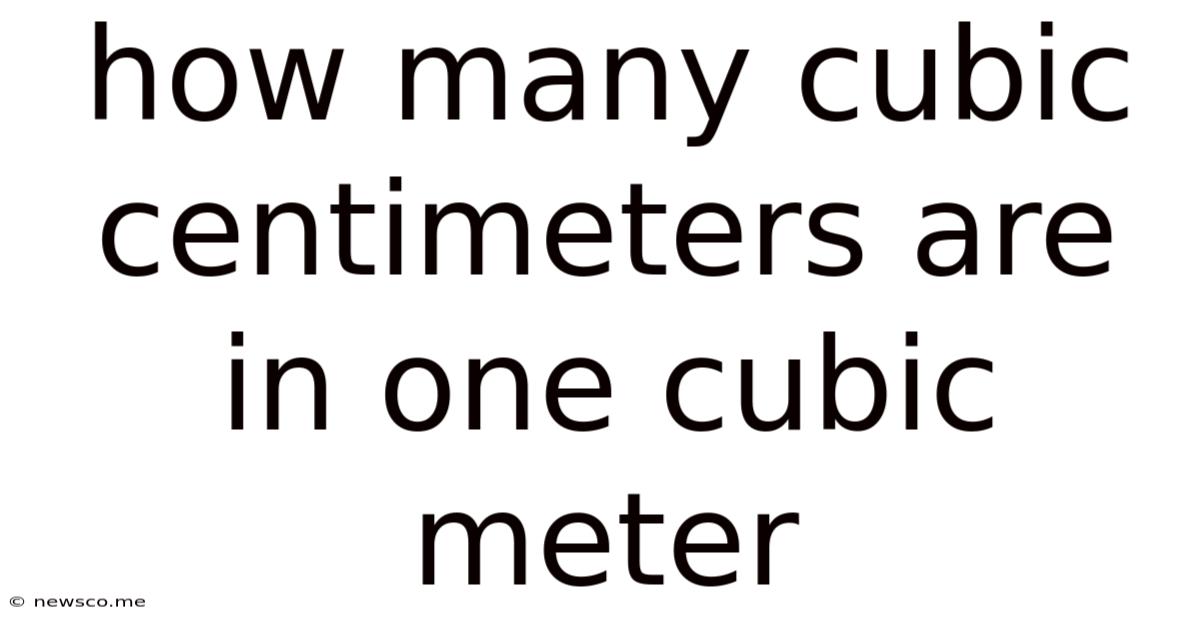How Many Cubic Centimeters Are In One Cubic Meter
News Co
Mar 29, 2025 · 4 min read

Table of Contents
How Many Cubic Centimeters are in One Cubic Meter? A Comprehensive Guide
Understanding unit conversions is crucial in various fields, from engineering and construction to everyday life. One common conversion that often causes confusion is the relationship between cubic centimeters (cm³) and cubic meters (m³). This comprehensive guide will not only answer the question "How many cubic centimeters are in one cubic meter?" but also delve into the underlying principles and provide practical applications to solidify your understanding.
Understanding Cubic Measurements
Before diving into the conversion, let's clarify what cubic measurements represent. A cubic unit is a measure of volume, representing the space occupied by a three-dimensional object. It's calculated by multiplying the length, width, and height of a cube or any rectangular prism.
-
Cubic Centimeter (cm³): This is a relatively small unit of volume, often used for measuring smaller objects or quantities of liquids. Imagine a cube with sides measuring 1 centimeter each. The volume of this cube is 1 cm³.
-
Cubic Meter (m³): This is a significantly larger unit of volume, frequently used in construction, engineering, and large-scale projects. Imagine a cube with sides measuring 1 meter each. The volume of this cube is 1 m³.
The Conversion: Cubic Centimeters to Cubic Meters
The core question we're addressing is the conversion factor between cm³ and m³. The key lies in understanding the relationship between centimeters and meters. There are 100 centimeters in 1 meter (1 m = 100 cm). However, since we're dealing with cubic units, the conversion isn't as straightforward as simply multiplying by 100.
To convert from cubic centimeters to cubic meters, we need to consider the volume. Since volume is three-dimensional, we cube the conversion factor (100). This means:
1 m³ = (100 cm)³ = 1,000,000 cm³
Therefore, there are 1,000,000 cubic centimeters in one cubic meter.
This can be visualized as a large cube (1 m³) being filled with 1,000,000 smaller cubes (each 1 cm³).
Practical Applications and Examples
Understanding this conversion is crucial in various real-world scenarios:
1. Construction and Engineering
Imagine calculating the volume of concrete needed for a foundation. The dimensions might be given in meters, but the supplier might measure the concrete in cubic centimeters. Knowing the conversion allows you to accurately order the necessary amount of concrete. For example, a foundation with a volume of 5 m³ requires 5,000,000 cm³ of concrete.
2. Fluid Mechanics and Hydrology
In fluid mechanics and hydrology, dealing with large volumes of water is common. Measuring water flow in rivers or calculating the capacity of reservoirs often involves conversions between cubic meters and cubic centimeters. This is especially important for accurate water resource management and flood prediction.
3. Medical and Pharmaceutical Applications
In medical and pharmaceutical applications, precise measurements are essential. Drug dosages, liquid volumes in medical procedures, and even the volume of organs can be expressed in cubic centimeters. Understanding the conversion to cubic meters can be helpful in scaling up processes or conducting large-scale studies.
4. Scientific Research
Many scientific experiments involve precise volume measurements, particularly in chemistry and physics. Solutions are often prepared using cubic centimeters, and understanding the relationship with cubic meters can be crucial for scaling experiments or comparing results across different studies.
Further Exploring Volume Conversions
While we've focused on cm³ to m³, it's beneficial to expand your understanding to other volume units. Here are some other common conversions:
-
Cubic Millimeters (mm³) to Cubic Centimeters (cm³): There are 10 mm in 1 cm, so 1 cm³ = 1000 mm³.
-
Liters (L) to Cubic Centimeters (cm³): 1 liter is equal to 1000 cm³.
-
Liters (L) to Cubic Meters (m³): 1 m³ = 1000 L.
Mastering these conversions empowers you to seamlessly work across different unit systems and ensures accuracy in various calculations.
Tips for Accurate Conversions
To minimize errors when converting between cubic centimeters and cubic meters:
-
Use the correct conversion factor: Always remember that the conversion factor isn't 100, but 1,000,000 (100³).
-
Double-check your calculations: Before finalizing any calculations, verify your work to ensure accuracy.
-
Use online converters (with caution): While online converters can be helpful, understanding the underlying principles is essential to avoid errors and build a strong foundational knowledge.
-
Break down complex problems: When dealing with complex calculations, break the problem into smaller, manageable steps.
Conclusion
The conversion between cubic centimeters and cubic meters is a fundamental concept in various fields. Understanding that 1 m³ equals 1,000,000 cm³ is essential for accurate calculations and problem-solving. By mastering this conversion and understanding the underlying principles, you'll be better equipped to tackle various challenges requiring precise volume measurements in your professional and personal endeavors. This knowledge is invaluable for anyone working with measurements of volume, regardless of their field. Remember to always double-check your calculations and use appropriate tools to enhance accuracy. With consistent practice and attention to detail, you'll confidently navigate the world of cubic measurements.
Latest Posts
Related Post
Thank you for visiting our website which covers about How Many Cubic Centimeters Are In One Cubic Meter . We hope the information provided has been useful to you. Feel free to contact us if you have any questions or need further assistance. See you next time and don't miss to bookmark.